Cottage style gardens were the first American gardens, before it was America. When we were still part of the original British Empire, our gardens (not those of the wealthy) were a mixture of edibles, medicinals, and flowers. Most of what early Americans ate came from this garden, and their medicines as well. Annual and perennial flowers were added for cut flowers or fragrant beauty.
But where are our gardens leading us today? Many of us want a broad range of flowers, shrubs, and trees to grace the gardens we create. We also want vegetables, berries, and tree fruits. But how can we mix all these things together harmoniously? In the new Cottage Style garden. How do we get there?
There are elements to any design, that can be broken down into series of ideas. By looking at what once was a part of the American cottage style garden, we can recreate it into the new style, by adding in some new elements.
Elements of the Cottage Style Garden
1. Fences, Walls, and Gates
Originally, fences and walls were parts of the garden to keep livestock out. Before barbed wire, or even electric wire, sturdy fences and chest-high walls kept out the neighbor’s cows (and your own). Often, cows and horses grazed together in a community field or paddock, before fencing was even thought of.
Fencing was built of pickets, logs, woven willows, or latticed logs and brush. Whatever the owner could get easy and cheap. Walls were built of stone. Many now say, “How did they get all that done so quickly?” Well, it was before cell phones, TVs, computers, and grocery stores. If you did not keep a kitchen garden, you ate very little. The gardener was the farmer, butcher, and grocer for his family. They had to get the wall up.
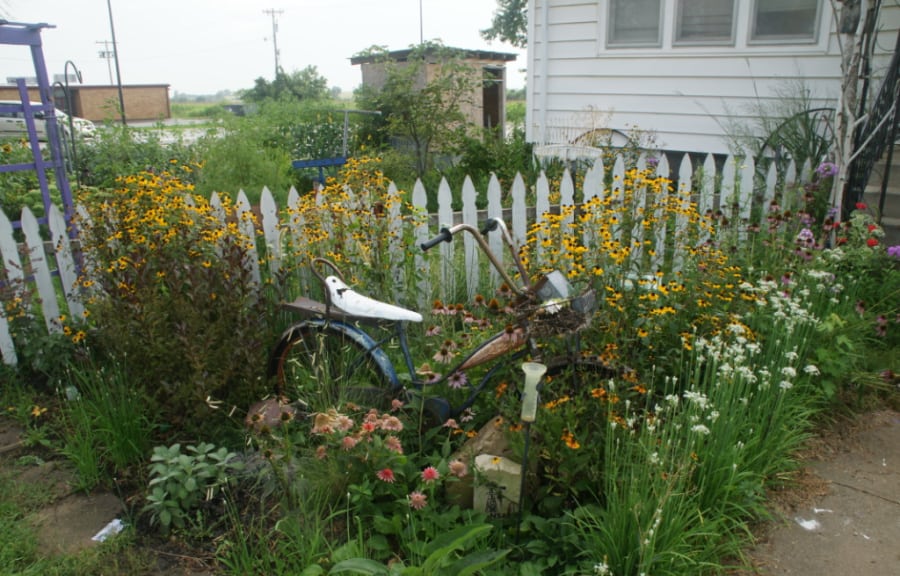
Nowadays, we are too busy at work, or on our phone, or at the computer, to put the effort in to the same kind of walls or fences that the early Americans did. We work in the evenings or weekends to get our gardening done. We hope that it will not take 10 years to put a wall around the garden. Or we hire it done.
2. Hedges
The hedge was often a dual purpose thing in the garden. It separated the various rooms of the garden and provided a backdrop for tall perennials and annuals. Most hedges are evergreen, from boxwood or yew. But some hedges could be fruitful as well as aesthetically pleasing, such as those from quince, chokeberry, or chokecherry.
Hedges were clipped to maintain a clean line at the back, even as the free-form flow of flowers cascaded around the rest of the property. They were grown often to screen an unsightly view, not necessarily the neighborhood like we do now. It might have been a tavern, or the roadway, or a mine. So many options.
Now, our biggest hedges screen off the neighbors and provide privacy in out gardens. Short hedges of finely clipped boxwoods, yews, or lavender make a design in a rose or herb garden, or keep borders in check.
3. Garden Rooms
If you do not separate the garden into rooms with paths and plants, walls and fences, it may start to feel like an overwhelming mess. By creating rooms in the garden, you create unique places to find for visitors, or cozy nooks for reading, for play, or for a party. Separating our the garden helps the cottage style bridge together itself, without the crazy chaos.
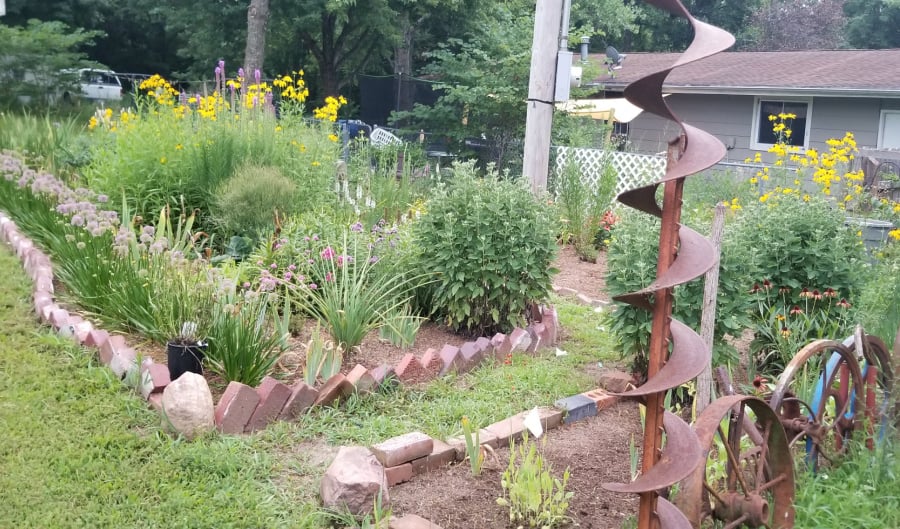
Path materials should be considered when planning how to get from room to room. Locally sourced materials are best used, and repeated to create a cohesive feel and look. Here in the Central Great Plains, crushed limestone, pea gravel, cedar mulch, or sedge/lawn works best as paved materials, for distances.
4. Backbone Plants
When you hear the words cottage style garden, what do you think of? Roses? Peonies? Old-fashioned flowers? I think of a myriad of flowers, herbs, and shrubs planted together in an inspired garden. But what about backbone plants, what are they? That would depend on where you live.
Backbone plants should be regionally sourced plants that can grow easily in your location, climate, and zone. If you are in desert, then cacti and succulents may be your backbone. In the mountains you may want to use conifers and alpines. Here in Northeast Kansas, at a crossroads of prairie and forest, my backbone plants might include oaks, hickories, native grasses, and prairie wildflowers.
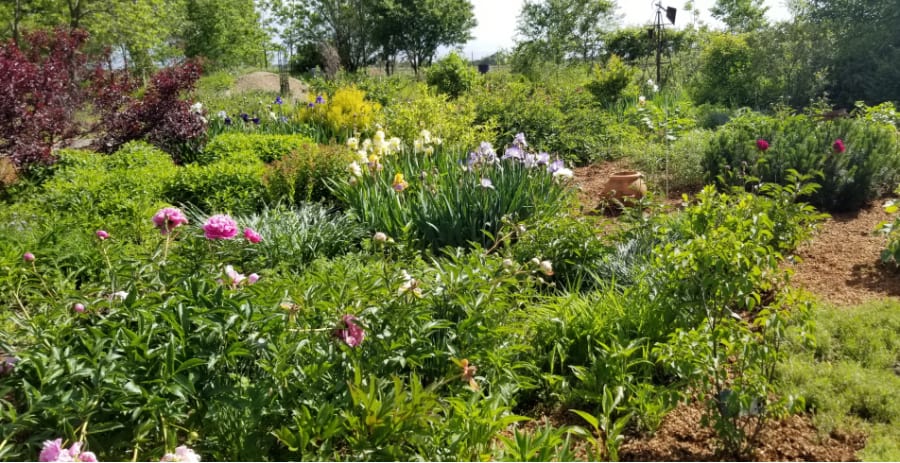
5. Ornamental Edibles
Remember, edibles were a big part of the early American cottage garden style. But if anything, they were the garden first, and flowers came second to them. Often though, edibles were prized for double features of ornament and edible. Things like grapes which could adorn and arbor, scarlet runner beans on a trellis, or cabbages grown between rows of dianthus (edible petals) and marigolds. \
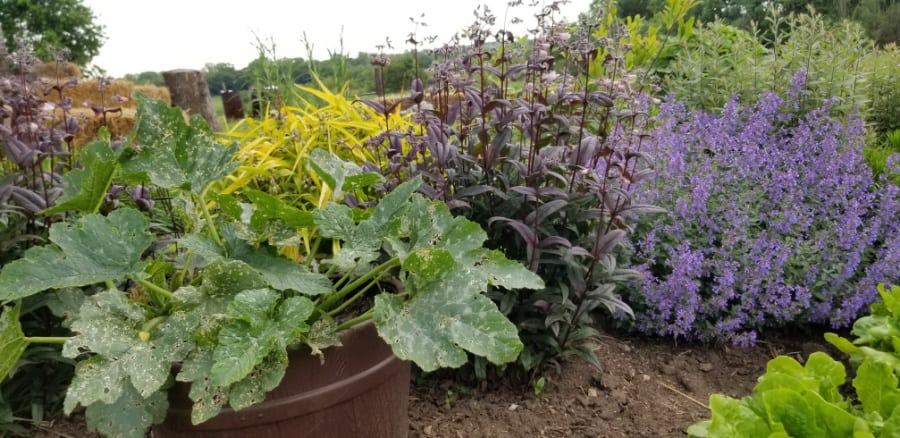
Herbs and other medicinal plants were also part of the garden. Many herbs and flowers pull this double use. Before the times of hospitals and local, town doctors, most women were in charge of keeping the family healthy. There might have been local yarbwomen or midwives who taught local women their herblore and garden techniques.
Now we can add even more edibles into the garden, with the ever-increasing variety of garden vegetables. Almost every nursery now carries a wide assortment of edibles for the landscape, from container sized tomatoes to small, bushy raspberries.
6. Twig or Rustic Elements
Using bent willow or twigs to shape gates, trellises, and arbors was quite common in early America. But most of us would not know where or how to begin using these elements in the garden. However, we have some other options that can mimic the look, or replace it altogether. Rustic.
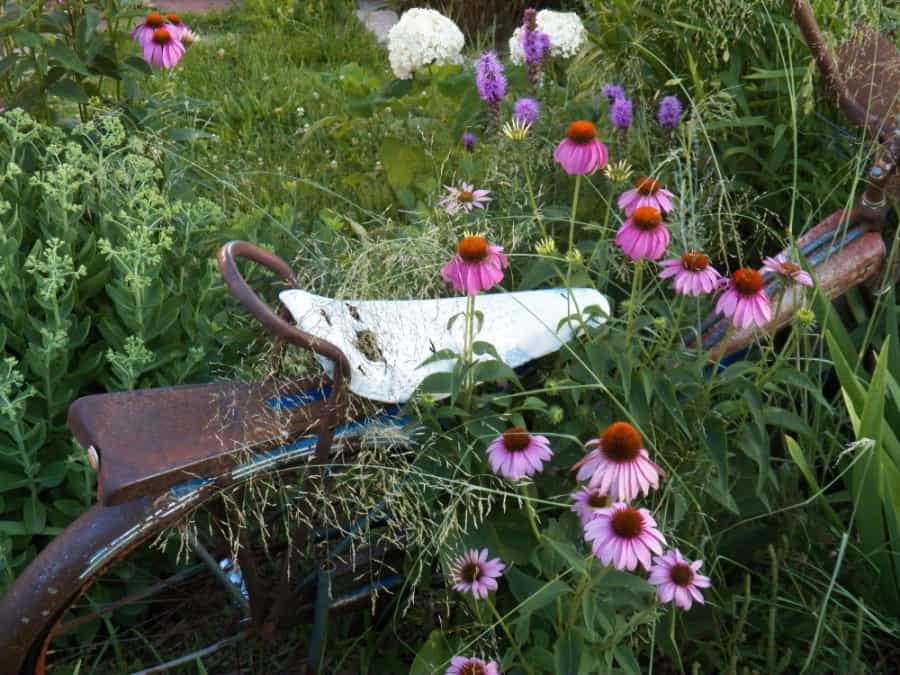
We have what the early Americans did not have, their old tools. We can find rustic tools, machinery, and parts in scrapyards, antique stores, and in our grandparent’s garage. Put together in an artful way, we can make gates, fences, and trellises. And it adds to the charm of the cottage style garden by tying us to those early gardeners.
7. Pottery and Containers
Large urns and pottery were not typically used by the lower classes of early American society, but they used what they could. If a cooking pot wore through it was turned into a planter for the garden. They also had wooden windowboxes and hanging baskets of willow. Today, we have the luxury of an overabundance of wire baskets, pottery, or metal containers to choose from.
I like to put smaller containers into groupings with complimentary colors around a central element. Or use a large container or urn with something rustic to add dimension. Containers can be anything that holds soil – a rusty chicken feeder, a mid-20th century welder with the top cut off, or even a porcelain sink.
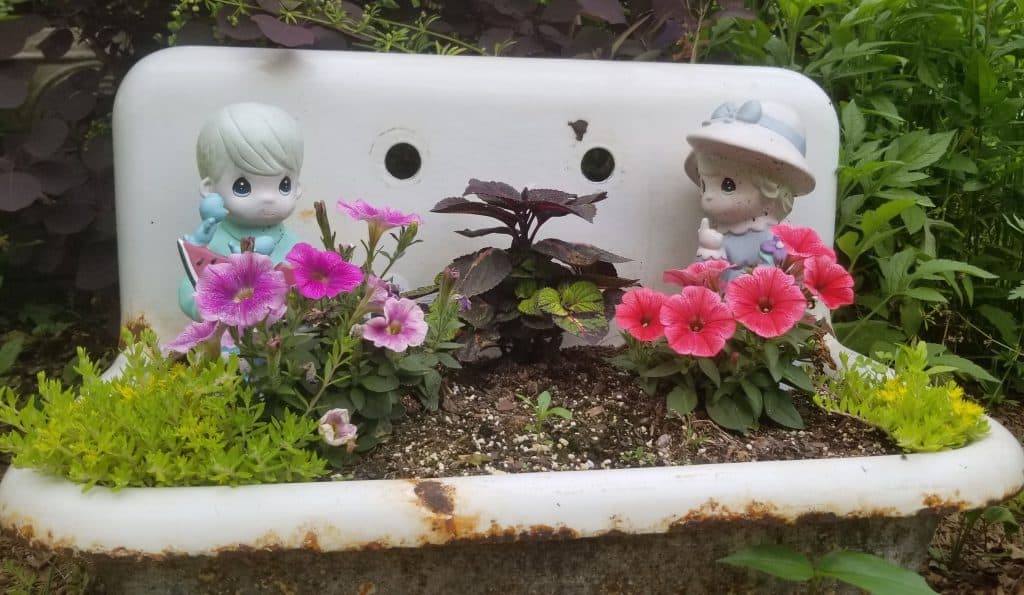
8. Water
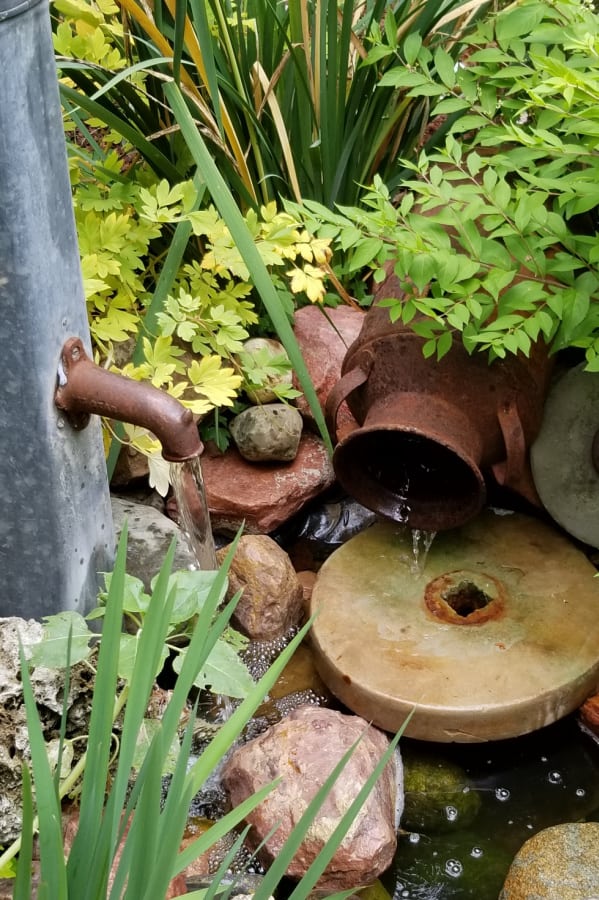
While water features or gardens were not part of the early American cottage style, we can make it part of the renewed style today. Individual fountains are easy to add in the garden. Adding the musical sounds of water into the garden helps relax the mind and calm the soul. And it is great for wildlife, from visiting honeybees to frogs and birds.
It does not have to be a huge display that takes up half the yard or a stream that meanders throughout the property. But a simple pottery fountain, a self-contained pump and bucket, or pondless waterfall may be just the right element in the garden.
9. Repeated Colors/Textures
This is done by using the same plants throughout the garden. It does not have to overwhelm to garden, just be a repetition of flowers that help tie the garden rooms together into a whole. Often, gardeners may repeat different structural elements through the garden, such as a trellis, obelisk, or garden tower. These tie garden rooms together.
Sometimes, just repeating a texture with differing plants can be enough. If using masses of grass, plant switchgrass, little bluestem, blue grama, and miscanthus in different places in the garden, tying the garden together with their texture.
Masses of Color in the Cottage Style Garden
While many cottage style gardens start out with a riot of colors, planted helter-skelter among the beds, the gardener soon realizes their mistake. Too many differing colors can quickly overwhelm the mind and chaos often ensues. But by massing flowers we give our eyes a resting place. The lawn has become the eye’s resting place in many of our gardens.
Massing does not mean that you cannot have continuous flowering in the garden, it just means you find ways to not have too many different flowers or colors at one time. Take a look at nature; it is the original cottage style garden. One of the most inspiring gardeners of the 21st century is Piet Oudolf, author of Planting: A New Perspective, and a garden designer who uses masses of plantings to mimic nature in urban settings.
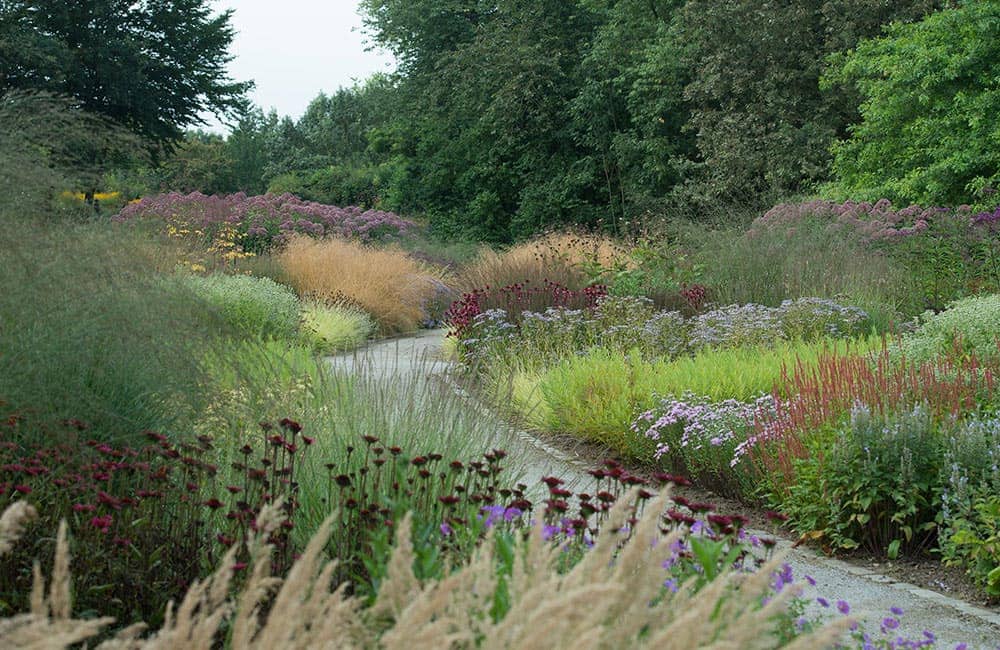
Biodiversity in the Garden
The cottage style garden may be the best thing for pollinators and declining North American insect populations. Because cottage style gardens are very diverse in their plantings, they attract a wide range of insects, as well as other animals. Birds, mammals, reptiles, amphibians, and other animals all flock to diverse plantings.
Choosing plants for the cottage style garden
When it comes time to do what most of us think is most fun – choosing plants, we are ready and willing. I think everyone who lives in the Central Great Plains and is planning a cottage style garden should choose plants first from the following plant families.
- Aster Family – includes coneflowers, asters, goldenrod, helenium, sunflowers, false sunflower, yarrow, coreopsis, joe pye, rudbeckia, blazingstars, and ironweeds among others
- Dogbane Family – includes dogbane, milkweeds, and bluestars
- Mint Family – includes agastache, mint, mountain mints, salvia, skullcaps, and stachys
- Bean Family – includes baptisia, prairie mimosa, senna, wild licorice, and prairie clovers
- Buttercup Family – includes anemones, columbine, clematis, delphiniums, and meadow-rues
- Verbena Family – includes verbenas, glandularia, and fogfruit
- Grasses – includes little bluestem, big bluestem, gramas, dropseeds, and switchgrass
Once members of these families are chosen, also pick your favorites from the other plant families, plus sedges, and non-native non-invasives from around the world. Choose plants that are suited for your conditions, as wells as those that have few pest and disease issues, and/or cultivars with disease resistance.
Flowers for continuous bloom
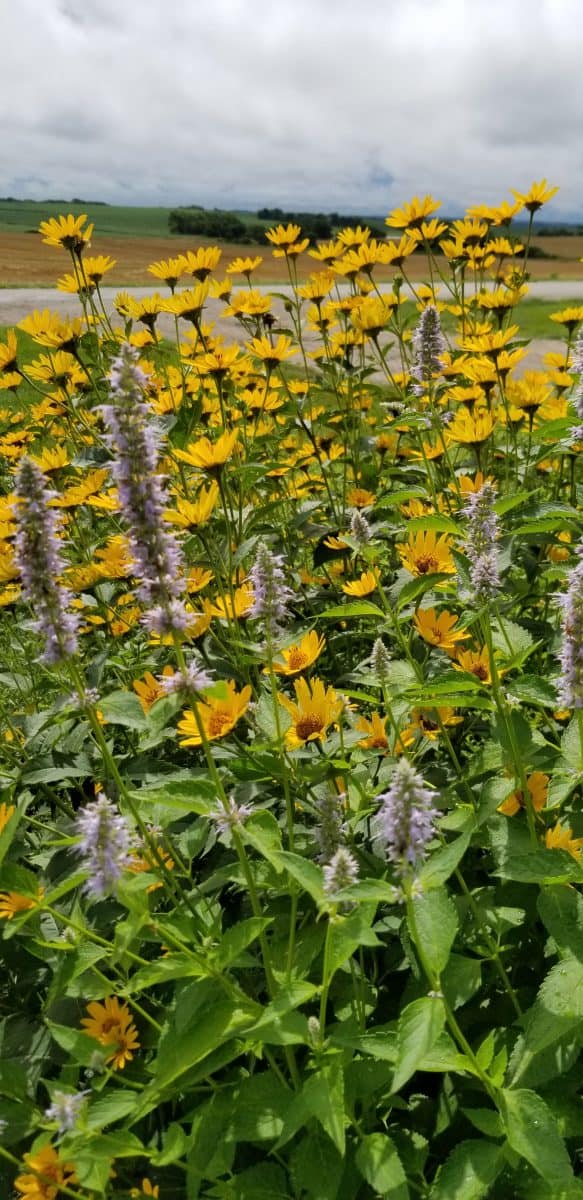
Over the years, while watching my own gardens and working in others, I have observed and recorded which flowers had the longest bloom times. Add together durability, drought resistance, and long-life spans, and you might have the best blooming flowers for gardens in the Central Great Plains.
Spring Blooming Flowers (April, May)
- Yellow Wood Poppy
- Blue Woodland Phlox
- Red Columbine
- Virginia Bluebells
- Rose Verbena
Summer Blooming Flowers (June, July, August, September)
- Agastache ‘Blue Fortune‘, ‘Little Adder‘
- Asclepias tuberosa ‘Hello Yellow’
- Swamp Milkweed
- Coreopsis ‘Crème Brulee‘, ‘Zagreb‘, ‘Mercury Rising‘
- Purple Coneflower
- False Sunflower
- Lychnis ‘Molten Lava’
- Catmint ‘Walker’s Low‘, ‘Cats Pajamas‘
- Garden Phlox
- Woolly Verbena
- Blue Lobelia
- Salvia ‘May Night’, ‘Lyrical Blues’, ‘Lyrical Rose‘
- Rudbeckia ‘American Gold Rush‘, ‘Little Henry’, ‘Henry Eilers’
- Rudbeckia triloba
- Rose Verbena
Fall Blooming Flowers (September, October)
- Willowleaf Sunflower ‘First Light’
- Garden Phlox
- Sedum ‘Autumn Fire’
- Aromatic Aster ‘Raydon’s Favorite’, ‘October Skies’
- Rose Verbena
- Blue Lobelia
Ornamental Edibles in the Cottage Style Garden
To create a true new American Cottage Style garden, you need to incorporate edibles with everything else. Now, edibles can mean fruit trees, berry bushes, grape or kiwi vines, or any mixture of perennial or annual vegetables. But making a harmonious landscape means using those edibles that can bring more to the garden while staying edible and easy to harvest.
Thanks to programs from the big nurseries, such as Proven Winners’ Proven Harvest, there are new options coming out all the time for vegetables for the stylish garden. Or start with the vegetables/fruits and incorporate the annual and perennial flowers in after.
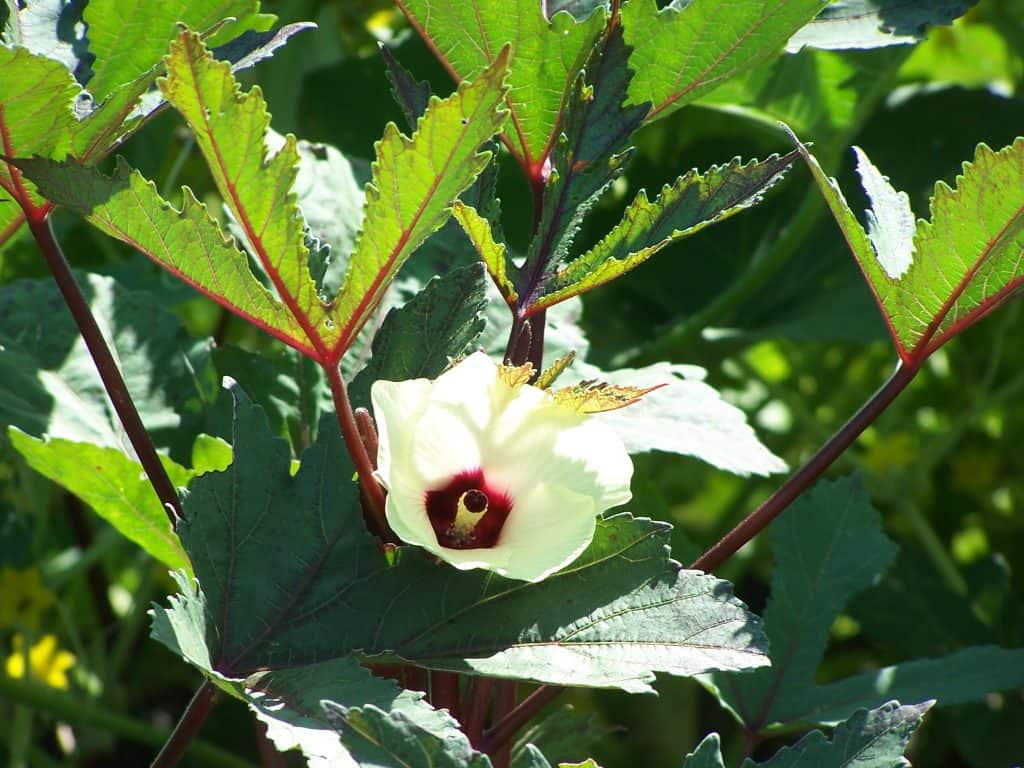
A sampling of ornamental vegetables for the cottage style garden
- Bush Bean ‘Dragons Tongue’
- Amazel Basil
- Radish ‘Easter Egg’
- Carrot ‘Circus Circus’
- Beet ‘Five Color Rainbow’
- Cucumber ‘Lemon’
- Kale ‘Mars Landing’
- Watermelon ‘Moon & Stars’
- Scarlet Runner Bean ‘Painted Lady’
- Rainbow Chard
- Lettuce ‘Sea of Red’
- Okra ‘Jing Orange’
Fruit for the cottage style garden
Incorporating fruit trees and bushes into the garden backbone can be challenging in enclosed spaces. But by using columnar and espalier fruit trees, made for containers berry bushes, and containerized tropicals. Being able to transfer containerized tropicals like figs, lemons, and limes to the garden from a sun room or greenhouse can help transform the cottage garden in summer.
- Blueberry ‘Pink Lemonade’
- Grape ‘Concord Seedless’
- Variegated Meyer Lemon
- Fig ‘LSU Purple’
- Brazelberry ‘Raspberry Shortcake’
- Brazelberry ‘Jelly Bean’ Blueberry
- Blackberry ‘Baby Cakes’
- Apple ‘Crimson Spire’
- Apple ‘Emerald Spire’
Conclusion
American gardeners can be satisfied with knowing that they are part of a new movement of cottage style gardening. Recreating the American cottage garden should be a part of most true gardener’s plans, as the edible movement sweeps the country. More and more people are turning to gardening as a means for adding to their pantry, for well-being, and for something to do that leaves you feeling better at the end.
Happy planting!

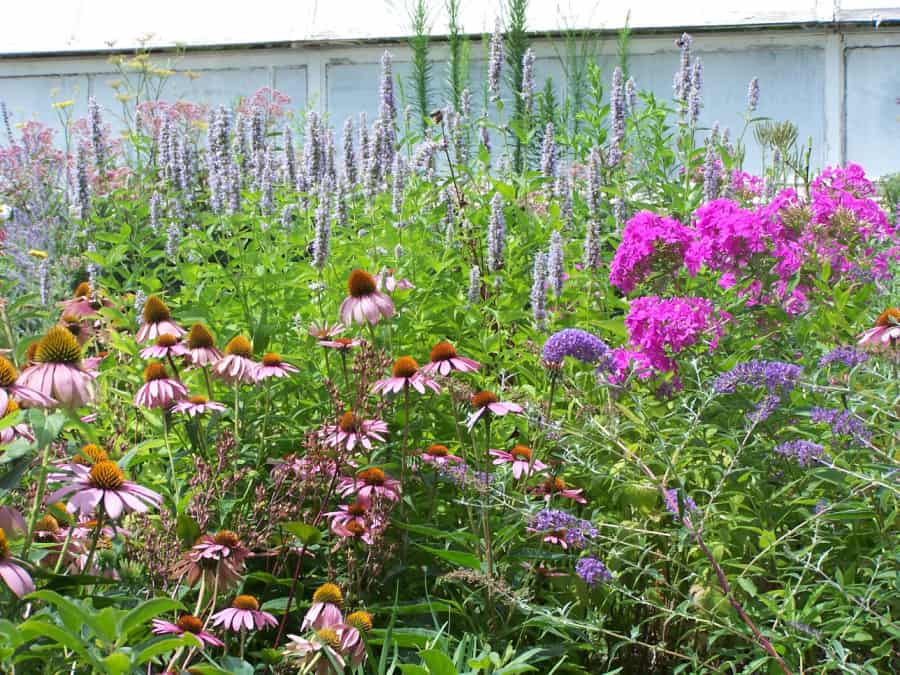



Excellent article. Full of solid suggestions as opposed to just verbiage. Thank you!!